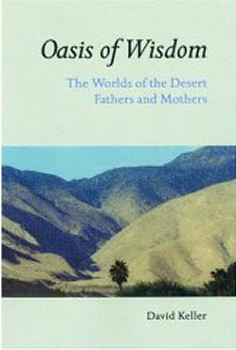
|
Posted October 27, 2005
Book: Oasis of Wisdom: The Worlds of the Desert Fathers and Mothers Author: David G. R. Keller Liturgical Press, Collegeville, MN, pp. 181 An Excerpt from the Jacket and Introduction:
“The church historian Irenee Hausherr, S.J., comments; ‘If you study the history of spirituality or the spiritual life of the Church, you will find that each time that there is a spiritual renewal in the Church, the desert fathers are present.’” An Excerpt from the Book: The monk’s experience of God in the cell occurred in a variety of ways, but the role of meditation on the Scriptures, the Word of God, was central. The Bible was central, but not as an end in itself. It provided a monk, through meditation, with opportunities to encounter the Spirit in prayer for personal guidance and discernment, not simply as “knowledge,” but as “encounter.” For interpretation of the Bible, the imperative is to probe beyond the letter and history to the spiritual mysteries (sacramenta) within, to get under the skin of the text and live inside it so that the biblical words become one’s own spiritual bones, sinews, and flesh.” This understanding of Scripture as “personal encounter” reflects the thought and experience of Origen of Alexander. As we have seen, he taught that within a person’s recitation of and meditation on Scripture a grace is present through which that person is led beyond the meanings of the words to experience the divine Presence unique to that person’s experience. The monks in Egypt had access to the Bible in their own Coptic language and would have heard Scripture in the liturgy and in the teaching of their mentors. They were able to memorize great portions of Scripture and many of those who were illiterate were taught to read. In the same way that the Bible was not an end in itself for prayer and meditation, it was never divorced from the pastoral and practical activities of daily life: “The silence and solitude of the desert, for instance, which so clearly revealed the hidden motivations of the heart, focused the attention of the desert fathers upon moral, ascetical, and psychological questions in a particularly acute way. The practical orientation of the desert fathers means that interpretation of Scripture in the Sayings almost never occurs for its own sake, but is embedded in the life and concerns of the desert.” In this way, the Bible was an integral part of the personal transformation that took place in the cell. One could say that the Bible was part of the mystical “topos” [topos=the cell, a specific place or location] of the cell and led the monk to contemplate his or her true “content” as a human being. Table of Contents: 1. Politeia: The monastic world of the desert Father and Mothers 2. Oikoumene: The inhabited worlds surrounding the desert Fathers and Mothers 3. Sunrise to sunrise: The daily lives of early Egyptian desert elders and monastic communities 4. The cell: meeting God and ourselves 5. Patience: learning not to run from God or ourselves 6. Stillness and silence: being present to God, ourselves, and the world 7. Praxis: An ascetic vocation that forms, nourishes and guards the soul 8. Praxis and labor: The sanctification of daily life 9. Humility: Making Christ tangible 10. Two deserts |
|
